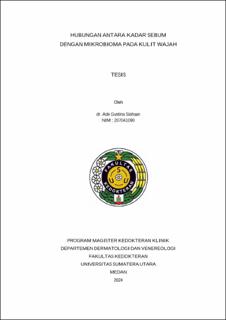Hubungan Antara Kadar Sebum dengan Mikrobioma pada Kulit Wajah
The Relationship between Sebum Levels and Microbiome on Facial Skin

Date
2024Author
Siahaan, Ade Gustina
Advisor(s)
Jusuf, Nelva Karmila
Putra, Imam Budi
Metadata
Show full item recordAbstract
Background: Sebum is a mixture of nonpolar lipids largely synthesized de novo by the sebaceous glands. Sebum plays a crucial role in maintaining skin moisture and providing nutrients for microorganisms residing on the skin. The skin microbiome is a collection of microorganisms that help prevent the invasion of pathogens. The interaction between the host and the microbiome on the skin is a dynamic relationship. Understanding the composition and characteristics of the microbiome on facial skin is an important factor in comprehending facial skin health and developing care plans. Research to determine the relationship between sebum levels and the microbiome on facial skin has never been conducted in Indonesia, particularly in North Sumatra.
Objective: To investigate the relationship between sebum levels and the microbiome on facial skin.
Subjects and Methods: This study is an observational analytic study with a cross-sectional approach involving 50 research subjects. Sebum levels were measured using a sebumeter in 5 facial areas. Microbiome identification was performed by aerobic and anaerobic bacterial culture on growth media, followed by identification using the Vitek® 2 system. The data were analyzed using the Independent T-test.
Results: This study found that the average age of the subjects was 34.62 years. There were more female subjects (72%) than male subjects (28%). The average sebum level was 90.46±18.38%. The most abundant aerobic bacteria are Staphylococcus sp. and Micrococcus sp. The most abundant anaerobic bacteria are Actinomyces naeslundii and C. acnes. There is a significant difference in sebum levels between aerobic and anaerobic bacteria (p=0.004).
Conclusion: There is a relationship between sebum levels and the microbiome on facial skin.
